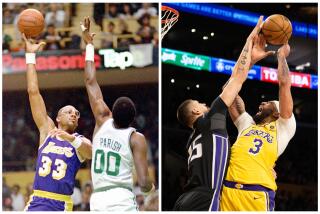Guarding Against Face, Mouth Injury in Sports for Youth
- Share via
Your child, the budding baseball star, heads for the diamond wearing a spanking clean uniform, sturdy shoes, a cap, a well-fitting mitt and a confident swagger.
What’s missing from this picture are two things that might spare you a trip to the emergency room: a mouth guard and a face guard.
For years, these protective devices have been used in “collision sports” like hockey and football. But now, growing numbers of dentists are calling for widespread use in non-contact youth sports, claiming that these devices could dramatically reduce injuries.
“We have a campaign to persuade organized youth baseball and softball to mandate the use of mouth guards and face shields,” says John Bogert, executive director of the American Academy of Pediatric Dentistry.
The effort springs from statistics suggesting these sports are more hazardous than they might seem, especially to the mouth and face.
In 1990, 140,000 children, ages 5-14, were treated in emergency rooms for injuries related to baseball, according to data presented last year at a U.S. Consumer Product Safety Commission summit on safety in youth baseball and softball. Many of those injuries were to the teeth or face.
For every 100 players in a youth league, at least one player will end up in the emergency room for injury treatment, experts reported. While the injury rate is low compared to other activities such as bike riding, experts say many softball and baseball injuries are preventable.
And in a University of Alabama survey of nearly 2,500 high school football players, 222 reported oral injuries and 64 reported concussions. Seventy-five percent of the injuries occurred when athletes did not wear mouth guards.
The effect of widespread mouth-guard use in ice hockey proves it can help reduce oral injuries in other sports, says Cosmo Castaldi, past president of the Academy of Sports Dentistry and professor emeritus of pediatric dentistry at the University of Connecticut. Before 1975, injuries of the head and face were most common of all ice hockey injuries, Castaldi wrote in the journal Sports Dentistry. Today, such injuries have been all but eliminated in amateur ice hockey, he says.
And some experts are calling for even more widespread use.
Says Stephen Mills, a Scarborough, Me., pediatric dentist: “I recommend mouth guards for kids in all contact sports.”
The American Dental Assn. also encourages mouth protection while engaging in “vigorous sports activities that could harm the facial region.” On that list, among other sports, are weightlifting, acrobatics, basketball, gymnastics, handball and martial arts. (When protection is worn, more than 200,000 oral injuries are prevented each year in high school and college football alone, according to the ADA.)
The ADA recommendation applies even if a young player still has baby teeth, says Castaldi. That is because a mouth guard does not just protect a child from a knocked-out tooth. It can also reduce concussion and jaw fracture, experts say. The ADA recommends covering only the upper teeth, since they usually overlap and protect lower teeth. Front teeth are also the most frequent site of injuries.
Some coaches consider mouth guards and face guards an extra expense, but Mills says, “When you consider the simplest dental injury would probably require an exam, an X-ray and a consultation you are easily talking $50 just to walk into a dental office.”
While face guards are readily available at most sporting goods stores, mouth guards either are ready-made or custom-fitted by a dentist.
Ready-made are available at sporting goods and discount stores for $3 or less. Some are stock-size; others are mouth-formed--designed to be dipped into boiling water, cooled, and placed into the mouth. As the wearer bites down, the guard is fitted to individual teeth.
Mouth guards custom-fitted by a dentist, which cost $50 or more, are preferred by the Academy of Pediatric Dentistry, but most experts acknowledge that any type mouth guard is better than none.
Children with braces can easily wear ready-made mouth guards, Bogert says. But the ADA suggests such children might want to seek professional help in fitting the ready-made guards or opt for professionally fitted models. A new technique makes it easier to fit kids with braces. The custom-fitted guards do not interfere with speech or breathing as the ready-made ones can.
“Sports and Your Child” is a brochure by the American Academy of Pediatrics that discusses injury risks and prevention. Send a self-addressed, business-size envelope to the American Academy of Pediatrics, Department C, P.O. Box 927, Elk Grove, Ill. 60009-0927.
More to Read
Go beyond the scoreboard
Get the latest on L.A.'s teams in the daily Sports Report newsletter.
You may occasionally receive promotional content from the Los Angeles Times.










